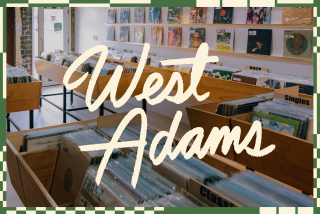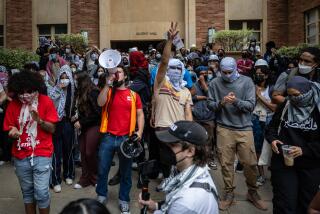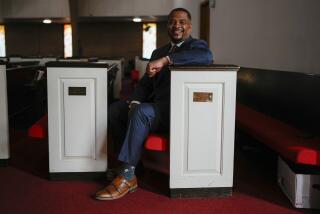10 things you might not know about the South Side
- Share via
1. Why is the South Side neighborhood southeast of Pershing Road and Halsted Street called Canaryville? According to the “Encyclopedia of Chicago,” the name may refer to “sparrows who populated the area at the end of the 19th century, feeding off stockyard refuse and grain from railroad cars.” But the name may also relate to the neighborhood’s tough youths, known as “wild canaries.”
2. The World’s Columbian Exposition of 1893, located along the lakefront from 56th to 67th streets, made the South Side home to many “firsts”: the first Ferris wheel, the first sales of a treat later called Cracker Jack, and the debut of a fictional pancake maker named Aunt Jemima. A pancake mix company hired Chicagoan Nancy Green, a former Kentucky slave, to play Jemima at the fair. Political correctness was many decades away. Fairgoers got buttons with Green’s likeness and the words “I’se in town, honey.”
3. There’s an East Side on the South Side. Near the far southeast corner of the city, the East Side neighborhood has had three previous names: Taylorville, Goosetown and Colehour.
4. Pill Hill was so named because so many doctors called it home. Today, the neighborhood nestled inside Calumet Heights is still the upscale home to many professionals. The area also gave its name to a play by Samuel Kelley. The work, about a group of friends growing up in Chicago from 1973 to 1983, is three hours plus and was called “ambitious” in a 1994 Tribune review but “interminable” in its 1999 revival.
5. One of the last suburbs to become a Chicago neighborhood was Morgan Park on the Far South Side. It wasn’t love at first sight. The 20-year annexation battle started in 1894 with a street fight between a Methodist minister and a politician, and included fistfights at village meetings, accusations of vote fraud, a banking scandal, state legislation, an Illinois Supreme Court ruling and a prank attempt by Morgan Park to annex Chicago. Before they officially joined the city in 1914, residents had gone to the polls eight times (six times voting no and two times yes).
6. The neighborhood of Douglas, which the city’s map now splits into Prairie Shores and Lake Meadows, includes land donated by the family of Sen. Stephen Douglas, Abraham Lincoln’s rival. During the Civil War, Camp Douglas at 31st Street and Cottage Grove Avenue was a horrific prisoner of war camp where thousands of Confederates died of abuse and disease. The dead were eventually buried at Oak Woods Cemetery, and today these soldiers who fought against emancipation rest alongside such African-American legends as Harold Washington and Jesse Owens.
7. The first fingerprints used to convict an American of murder were found in Englewood. Thomas Jennings was burglarizing a house in 1910 when the homeowner confronted him. Jennings killed him. He also left fingerprints on a freshly painted railing outside the house, and police later picked him up as a suspicious character. Based on the fingerprints, he was convicted and hanged.
8. The White City amusement park, billed as “the city of a million electric lights,” opened around 1905 and operated until the late ‘30s at 63rd Street and South Park. Goodyear’s first commercial blimp, the Wingfoot, was assembled and hangared there. While sailing from Grant Park toward White City in 1919, the Wingfoot plunged through the skylight of a downtown bank, killing 10 bank employees and three people on the blimp.
9. Many amazing South Side sites have disappeared, including Frank Lloyd Wright’s Midway Gardens entertainment complex at 60th and Cottage Grove and the Washington Park Racetrack at 61st and Cottage Grove. A less regrettable loss was the Robert Taylor Homes, a row of high-rises along the Dan Ryan Expressway that was considered a public housing failure. The development was named for Chicago Housing Authority board member Robert Taylor, grandfather of White House adviser Valerie Jarrett.
10. The Levee was a vice district around 20th and State streets with houses of ill repute bearing such colorful names as Bucket of Blood, Why Not and the Library. (A husband could tell his wife he was going to the Library and would not be lying.) Do-gooders closed the Levee in 1912, dispersing prostitution elsewhere in the city and suburbs.
Mark Jacob is a deputy metro editor at the Tribune; Stephan Benzkofer is weekend editor.
Sources: “Encyclopedia of Chicago”; “Streetwise Chicago” by Don Hayner and Tom McNamee; “Chicago and its Suburbs” by Everett Chamberlin; “Chicago Sketches” by June Skinner Sawyers, “Chicago Politics, Ward by Ward” by David K. Fremon; “Slave in a Box: The Strange Career of Aunt Jemima” by M.M. Manring; “Peanuts” by Andrew F. Smith; “Chicago Neighborhoods and Suburbs: A Historical Guide,” edited by Ann Durkin Keating; and Tribune archives
More to Read
Sign up for The Wild
We’ll help you find the best places to hike, bike and run, as well as the perfect silent spots for meditation and yoga.
You may occasionally receive promotional content from the Los Angeles Times.






